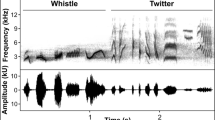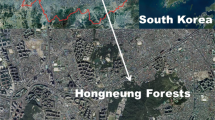Abstract
The age-related variability of the frequency and structural–temporal parameters of the advertising song of Ficedula hypoleuca males in natural habitats and the urban environment were analysed. In the natural habitats, the range of male song frequencies, the maximal frequency, the number of figures, and the length of the song decreased from the third year of life. Similar age-related song changes in urban birds are observed earlier, from the second year of life. Urban birds have shown that the higher minimum song frequency increases with age, adapting the song to noise pollution.






Similar content being viewed by others
REFERENCES
Adret-Hausberger, M., Güttinger, H.R., and Merkel, F.W., Individual life history and song repertoire changes in a colony of starlings (Sturnus vulgaris), Ethology, 1990, vol. 84, no. 4, pp. 265–280.
Artem’ev, A.V., Populyatsionnaya ekologiya mukholovki-pestrushki v severnoi zone areala (Population Ecology of the Pied Flycatcher in the Northern Part of Its Range), Moscow: Nauka, 2008.
Bastrikova, A.E. and Gashkov, S.I., Differences in the advertising song of male pied flycatcher (Ficedula hypoleuca Pall.) of different ages, Printsipy Ekol., 2016, vol. 5, no. 3(19), p. 25.
Bastrikova, A.E. and Gashkov, S.I., Frequency-time characteristics of the pied flycatcher (Ficedula hypoleuca) song under conditions of anthropogenic noise pollution, in Ekologiya i evolyutsiya: novye gorizonty: materialy Mezhdunarodnogo simpoziuma, posvyashchennogo 100-letiyu akademika S.S. Shvartsa, Ekaterinburg, 1–5 aprelya 2019 g. (Proceedings of the International Symposium Dedicated to the 100th Anniversary of Academician S.S. Shvarts “Ecology and Evolution: New Horizons,” Yekaterinburg, April 1–5, 2019), Yekaterinburg, 2019, pp. 12–14.
Beme, I.R., Goretskaya, M.Ya., and Moskalenko, V.N., Immunization with a non-replicating antigen leads to changes in song characteristics and the level of corticosterone in passerine birds, Dokl. Biol. Sci., 2014, vol. 454, pp. 19–21.
Berger-Tal, O. and Saltz, D., Invisible barriers: anthropogenic impacts on inter-and intra-specific interactions as drivers of landscape-independent fragmentation, Philos. Trans. R. Soc., B, 2019, vol. 374, no. 1781, art. 20180049.
Catchpole, C.K. and Slater, P.J.B., Bird Song: Biological Themes and Variations, New York: Cambridge Univ. Press, 2008.
Desrochers, A., Age and foraging success in European blackbirds—variations between and within individuals, Anim. Behav., 1992, vol. 43, pp. 885–894.
Eens, M., Pinxten, R., and Verheyen, R., No overlap in song repertoire size between yearling and older starlings, Sturnus vulgaris, Ibis, 1992, vol. 134, pp. 72–76.
Eriksson, D. and Wallin, L., Male bird song attracts females—a field experiment, Behav. Ecol. Sociobiol., 1986, vol. 19, no. 4, pp. 297–299.
Espmark, Y.O. and Lampe, H.M., Variations in the song of the pied flycatcher within and between breeding seasons, Bioacoustic, 1993, vol. 5, pp. 33–65.
Galeotti, P., Saino, N., Perani, E., Sacchi, R., and Moller, A.R., Age-related song variation in male barn swallows, Ital. J. Zool., 2001, vol. 68, pp. 305–310.
Garamszegi, L.Z., Heylen, D., Moller, A.P., Eens, M., and De Lope, F., Age-dependent health status and song characteristics in the barn swallow, Behav. Ecol., 2005, vol. 16, pp. 580–591.
Garamszegi, L.Z., Török, J., Hegyi, G., Szöllõsi, E., Rosivall, B., and Eens, M., Age-dependent expression of song in the collared flycatcher, Ficedula albicollis, Ethology, 2007, vol. 113, no. 3, pp. 246–256.
Gashkov, S.I., Relationship with the territory of birth and reproduction of the pied flycatcher (Ficedula hypoleuca Pall.) on the eastern periphery of the range, Vestn. Tomsk. Gos. Univ., Suppl., 2003, no. 8, pp. 35–40.
Grinkov, V.G. and Gashkov, S.I., Living on the edge: new data about the pied flycatcher (Ficedula hypoleuca) breeding in Western Siberia, Russia, Vogelwarte, 2003, vol. 42, pp. 3–27.
Grinkov, V.G., Bauer, A., Gashkov, S.I., Sternberg, H., and Wink, M., Diversity of social-genetic relationships in the socially monogamous pied flycatcher (Ficedula hypoleuca) breeding in Western Siberia, PeerJ, 2018, vol. 6, pp. e6059–e6059.
Hill, S.D., Aryal, A., Pawley, M.D., and Ji, W., So much for the city: urban-rural song variation in a widespread Asiatic songbird, Integr. Zool., 2018, vol. 13, no. 2, pp. 194–205.
Ioganzen, V.G., Observations on nesting of the pied flycatcher (Muscicapa atricapilla Linn.) in the vicinity of Tomsk, Ornitol. Vestn., 1914, no. 4, pp. 293–295.
Ioganzen, G.E., Tomsk pied flycatcher, Ornitol. Vestn., 1916, no. 2, p. 101.
Irwin, D., Song variation in avian ring species, Evolution, 2000, vol. 54, pp. 998–1010.
Ivanitskii, V.V., Antipov, V.A., and Marova, I.M., Thrush nightingale (Luscinia luscinia) in Moscow and Moscow oblast: urban noise affects the frequency parameters of the song, Zool. Zh., 2014, vol. 93, no. 9, pp. 1123–1130.
Ivanova, M.N., The relationship between the type of color, age, and acoustic characteristics of the song in males of the pied flycatcher, Ornitologiya, 1998, vol. 28, nos. 1–2, pp. 126–135.
Johnson, L.S. and Searcy, W.A., Female attraction to male song in house wrens (Troglodytes aedon), Behaviour, 1996, vol. 133, pp. 357–366.
Kiefer, S., Sommer, C., Scharff, C., Kipper, S., and Mundry, R., Tuning towards tomorrow? Common nightingales Luscinia megarhynchos change and increase their song repertoires from the first to the second breeding season, J. Avian Biol., 2009, vol. 40, pp. 231–236.
Koval’, Z.V., Assessment of noise pollution of the Kirovskii district of Tomsk, M.S. Thesis, Tomsk: Tomsk State Univ., 2019.
Krebs, J.R., The significance of song repertoires: the Beau Geste hypothesis, Anim. Behav., 1977, vol. 25, pp. 475–478.
Kuranov, B.D., Breeding biology of the urbanized population of the pied flycatcher (Ficedula hypoleuca), Vestn. Tomsk. Gos. Univ., 2007, no. 297, pp. 192–200.
Kuranov, B.D., Maintenance of the pied flycatcher Ficedula hypoleuca at the eastern boundary of its range, Russ. Ornitol. Zh., 2017, vol. 26, no. 1425, pp. 1291–1300.
Lundberg, A. and Alatalo, R.V., The Pied Flycatcher, London: Poyser, 1992.
Luther, D.A. and Baptista, L., Does urban noise influence the cultural evolution of bird songs?, Proc. R. Soc. London, Ser. B, 2010, vol. 277, рр. 469–473.
Luther, D.A. and Derryberry, E.P., Birdsongs keep pace with city life: changes in song over time in an urban songbird affects communication, Anim. Behav., 2012, vol. 83, no. 4, pp. 1059–1066.
McDonald, M.V., Function of song in Scott’s seaside sparrow, Ammodramus maritimus peninsulae, Anim. Behav., 1989, vol. 38, pp. 468–485.
Mendes, S., Colino-Rabanal, V.J., and Peris, S.J., Diferencias en el canto de la ratona común (Troglodytes musculus) en ambientes con distintos niveles de influencia humana, El hornero, 2011, vol. 26, no. 2, pp. 85–93.
Møller, A.P., Henry, P.Y., and Erritzøe, J., The evolution of song repertoires and immune defence in birds, Proc. R. Soc. London, Ser. B, 2000, vol. 267, no. 1439, pp. 165–169.
Moran, M.D., Arguments for rejecting the sequential Bonferroni in ecological studies, Oikos, 2003, vol. 100, pp. 403–405.
Mountjoy, D.J. and Lemon, R.E., Song as an attractant for male and female European starlings, and the influence of song complexity on their response, Behav. Ecol. Sociobiol., 1991, vol. 28, pp. 97–100.
Nakagawa, S., A farewell to Bonferroni: the problems of low statistical power and publication bias, Behav. Ecol., 2004, vol. 15, pp. 1044–1045.
Nemeth, E. et al., Bird song and anthropogenic noise: vocal constraints may explain why birds sing higher-frequency songs in cities, Proc. R. Soc. London, Ser. B, 2013, vol. 280, no. 1754, pp. 1–7.
Nowicki, S., Searcy, W.A., and Hughes, M., The territory defense function of song in song sparrows: a test with the speaker occupation design, Behaviour, 1998, vol. 135, pp. 615–628.
Ojanen, M., A method for age determination of pied flycatcher Ficedula hypoleuca in spring, Acta Reg. Soc. Scien. Litter. Gothoburg. Zool., 1987, vol. 14, pp. 95–101.
Opaev, A.S., The main directions of the divergence of cryptic bird species: a case study of the “thrush warbler” complex, Extended Abstract of Cand. Sci. (Biol.) Dissertation, Moscow: Inst. Probl. Ecol. Evol., Russ. Acad. Sci., 2010.
Perneger, T.V., What’s wrong with Bonferroni adjustments, Brit. Med. J., 1998, vol. 316, pp. 1236–1238.
Roca, I.T., Desrochers, L., Giacomazzo, M., Bertolo, A., Bolduc, P., Deschesnes, R., Martin, C.A., Rainville, V., Rheault, G., and Proulx, R., Shifting song frequencies in response to anthropogenic noise: a meta-analysis on birds and anurans, Behav. Ecol., 2016, vol. 27, no. 5, pp. 1269–1274.
Slabbekoorn, H. and Peet, M., Birds sing at a higher pitch in urban noise—great tits hit the high notes to ensure that their mating calls are heard above the city’s din, Nature, 2003, vol. 424, pp. 267–268.
Smith, D.G., An experimental analysis of the function of red-winged blackbird song, Behaviour, 1976, vol. 56, pp. 136–156.
Smith, D.G., Male singing ability and territory integrity in red-winged blackbirds Agelaius phoeniceus, Behaviour, 1979, vol. 68, pp. 193–206.
Sokolov, L.V., Filopatriya i dispersiya ptits (Philopatry and Dispersal of Birds), Tr. Zool. Inst. Akad. Nauk SSSR, 1991, vol. 230, pp. 1–232.
Vysotskii, V.G., Determination of the age of the pied flycatcher (Ficedula hypoleuca) in the breeding season, in Fauna i ekologiya ptits Evrazii (Fauna and Ecology of Birds of Eurasia), Tr. Akad. Nauk Zool. Inst. SSSR, 1989, vol. 197, pp. 49–52.
Funding
The reported study was funded by RFBR according to the research project no. 20-34-90080.
Author information
Authors and Affiliations
Corresponding author
Ethics declarations
Conflict of interest. The authors declare that they have no conflict of interest.
Statement on the welfare of animals. All applicable international, national, and/or institutional guidelines for the care and use of animals were followed.
Rights and permissions
About this article
Cite this article
Bastrikova, A.E., Gashkov, S.I. & Moskvitina, N.S. Age-Related Variability of the Pied Flycatcher (Ficedula hypoleuca) Song in Natural and Urban Environments. Biol Bull Russ Acad Sci 48, 607–615 (2021). https://doi.org/10.1134/S1062359021050046
Received:
Revised:
Accepted:
Published:
Issue Date:
DOI: https://doi.org/10.1134/S1062359021050046




